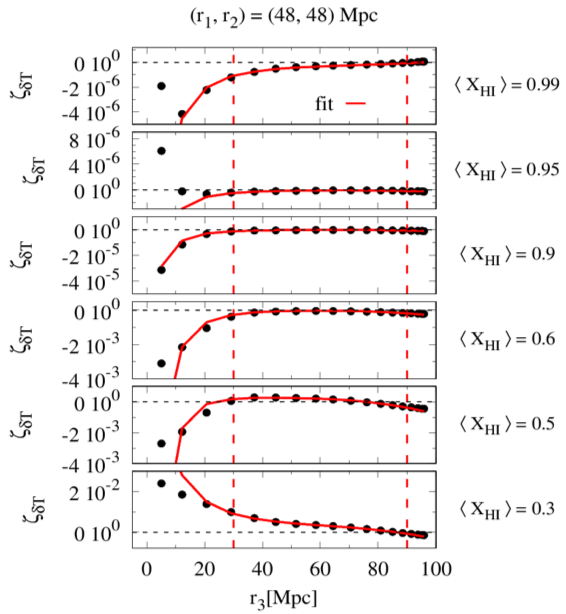Understanding neutral hydrogen clustering during re-ionization
Upcoming observations of cosmic radio signals will mark the beginning of a new era in cosmology as they will provide a first glance on the neutral hydrogen distribution in the early universe. These observations will give us insights into a key process in the evolution of the universe – the reionization of the neutral hydrogen by the first stars and galaxies. The neutral hydrogen distribution can be observed via photons, which are emitted by neutral hydrogen atoms at the wavelength of 21cm and are redshifted to radio signals during their journey through the expanding universe before being observed on earth.
In order to extract information about the physical processes which drive the reionization from future observations, we need to understand the statistical properties of the spatial fluctuations in this 21cm signal, which depend on how the neutral hydrogen is distributed in space as shown. These statistical properties can be characterized by so-called correlation functions. So far, research has been mainly focused on two-point correlation functions, which provide information about the scale dependence of the clustering. In a recent study, a team led by Dr. Kai Hoffmann, Prof. Yi Mao at Tsinghua University studied, for the first time, the 21cm three-point correlation function (3PCF) using simulations, which provides access to additional information about the morphology of ionized regions. Such additional information may improve constraints of reionization models from future observations.
For this purpose, a so-called quadratic bias model was employed, which has been originally developed for understanding the 3PCF of galaxies. The bias model provides a relation between the 3PCFs of the matter density and the 21cm signal. Using numerical simulations, this relation is found to hold at the 10% level at early times of reionization and at large scales (Fig. 1). The free parameters in the model are consistent with those extracted from the two-point statistics, indicating that the bias model is physically meaningful (Fig. 2). However, this model is found to break down at later time of reionization and at small scales, which calls for an improvement of the bias modeling in future studies.
The first author of this paper is Dr. Kai Hoffmann (postdoc at Tsinghua), and the corresponding author is Prof. Yi Mao (assistant professor at Tsinghua). The coauthors also include Prof. Ben Wandelt (Institute of Astrophysics at Paris).
(By Kai Hoffmann & Yi Mao)
Link to the relevant paper:
Hoffmann, K., Mao, Y., Mo, H., Wandelt, B., https://arxiv.org/abs/1802.02578





